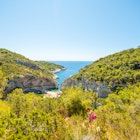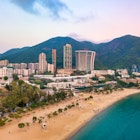
Nov 25, 2022 • 10 min read

A wall in Civil Society's rehersal space, replete with old gig posters, on Île de Gorée. Emmanuelle Andrianjafy / Lonely Planet
Welcome to diverse Dakar, capital of Senegal, where reggae resounds through subterranean hideaways, downtown nightclubs throb with world beats and homegrown pop, and the sounds of the djembe drum and kora are as vital as ever.
In a dingy underground corridor, within the fortifications of the old slave-trading port of Île de Gorée, the only sound is a rusty chain rattling against a steel door. In the dim light, Fallou Kandji works a key into a heavy padlock and struggles with it until he hears the dull click. Then the young man, his short dreads hidden beneath a red wool beret, flashes a magician’s smile before unlooping the chain and pushing the creaking door ajar. Heat rushes out as though he has opened an oven. Yellow paint flakes off the walls in the small, low-ceilinged room. Arranged around it are a full drumkit, keyboard, stacks of speakers and a pair of kora, the West African string instruments that paved the way for acoustic guitars. One wall is plastered with old gig posters, peeling in the sticky damp. This secret subterranean hideaway is the studio and rehearsal space of reggae band Civil Society, who have brought music to a place that once reverberated only with echoes of its horrific past.
'Here on Île de Gorée, people live through culture'
Sitting a little over a mile out from Dakar’s sheltered harbour, Île de Gorée is tiny and pretty, its narrow car-free streets leading between faded colonial buildings. It was Senegal’s most notorious port in the late 1700s, thought to be where millions of enslaved people passed through. Now visitors come to reflect at the Maison des Esclaves (House of Slaves), a museum and memorial enshrining the Door of No Return, an infamous passageway through which the museum's late founder believed hundreds of thousands of people were transported to the Americas. When President Obama visited the island in 2013 he took a moment to stand in the doorway and gaze out to sea. Later, he would say that the visit helped him ‘fully appreciate the magnitude of the slave trade’. These days the island has been reclaimed as a place of life and hope. Many who live here are artists. As well as playing guitar with Civil Society, Fallou is a painter. He leads me along nameless alleys to the yard where he keeps his battered acoustic guitar and displays his work, past vendors selling baguettes and kids playing football. We wave away the attention of his fellow artists loudly hawking their paintings jewellery and ornate sculptures. They don’t seem too discouraged. They’ll get us on the way back.
‘Here, people live through culture,’ Fallou tells me as we walk. ‘Once people were brought here by slavery. Now people from many different cultures pass through. People were deported from here to America, Haiti, Cuba, Brazil… anywhere. When they come now, I see only humans. When I look at you, I see myself. That’s what I try to show in my art and in my music.’ We pass by the House of Slaves, and pause in front of a statue depicting a woman with her arms around a man as he breaks his chains and raises his fists in triumph. The newly freed pair stand on the West African drum known as a djembe. ‘This is the symbol,’ points out Fallou. ‘They are using their power to get their liberty. It represents what people believe in here on Île de Gorée: that melody and harmony will pass around the world through communication.’
'Djembe rhythms shaped music genres the world over'
The djembe has been at the heart of West African music for many centuries. To learn more about the significance of this special drum, I take a ferry back to the mainland to visit the master drum-maker and teacher Ibou Sene. He gives lessons on how to build and play the djembe at his small workshop in the gardens behind the Cultural Centre in Derkle, near the centre of Dakar. As my taxi moves slowly through the gridlocked traffic, the air is thick with fine Saharan dust. It takes my eyes a moment to adjust to the yellowy light, through which I see herds of sheep gathered next to the highway. Their bleating mixes with engine noises and honking horns to create this industrious city’s particular cacophony. The car in front has the name Youssou N’Dour - one of Senegal’s most famous singers - painted on its spoiler. By the side of the road, three small boys sit back to back in a circle, drumming on upturned petrol canisters with their hands.

‘The drum is very important here,’ explains Ibou when I arrive. We sit on plastic garden chairs outside his workshop, under the shade of a baobab tree, and he patiently shows me the subtle changes in hand shape and positioning that produce traditional djembe drum patterns. ‘These were the cell phones of my parents’ generation,’ he says. ‘If you heard a certain rhythm being played by people walking around the neighbourhood, then you would know right away what had happened.’
These rhythms, which travelled across the sea from Senegal on board ships carrying enslaved people, would go on to shape musical genres the world over. One man who understands this better than most is Dread Amala, a reggae DJ and Dakar music historian who, for 30 years, has run the Bufalo Soldier Music Shop. A tiny shack on a dusty corner next to a petrol station at the Jet d’Eau roundabout, it doesn’t look like the most promising place to find an exhaustive collection of world music. When I step inside I find a cramped space piled high with vinyl from almost every country in Africa, as well as French and Cuban discs, jazz, blues, rock and lots and lots of reggae. Reggae is Dread Amala’s passion, so it’s fitting that in the taxi on my way here the radio was playing the South African artist Lucky Dube’s song Serious Reggae Business: ‘Some say it came from Jamaica, some say it came from Africa…’.
Touching a needle down onto a reggae track from his own collection, Dread Amala explains how the music he loves originated in this part of the world. ‘In slave culture you had drumming from Senegal, Mali and Guinea,’ he says. ‘That’s why in reggae music drumming is also important. The origin of all international music – blues, jazz, soul, reggae – is Africa. It all came from here.’ It would be easy to lose hours rummaging through Dread Amala’s crates, but to really experience Senegalese music I want to see it live. I head downtown to PLAYclub, in the basement of the Hotel Al Afifa, a slightly seedy-looking joint that appears to be largely unchanged since the 1970s. There are circular mirrors on the walls behind the bar, where a well-dressed bartender shakes a daiquiri in time to the music. Tonight’s main attraction, Woz Kaly, doesn’t come on until just after 1am. The set starts slow, showcasing the power of his singing in his native Wolof, before building to a hipshaking intensity that has the crowded room dancing and singing along. It’s not quite like anything I’ve heard anywhere else in the world.
'You can feel that everybody is at ease in Dakar'
As it turns out, Dakar is running a surplus of spectacular live performers. After seeing Woz Kaly in action I sit down with local pop sensation Adiouza, whose live shows are filled with such crowd-pleasing glamour and effortless dance moves they’ve led to her being dubbed ‘Senegal’s Beyoncé’. She modestly laughs off the comparison. ‘Beyoncé is a great singer,’ she says. ‘I listen to her songs, and to other American singers, but my real inspiration is traditional African roots musicians and singers. In my music you can hear traditional and modern music coming together.’
Adiouza released her first single in 2008, so she has watched from a front-row seat as Dakar’s music scene has broadened beyond the local style of pop, known as mbalax. ‘Dakar is the centre of Senegalese music, so there are a lot of different artists in different styles,’ she says. ‘You can find artists who do reggae, hip-hop and Cuban music. Me, I mix every type of music to find my own style.’
While Adiouza is happily mainstream, she keeps her ear close to the ground and is excited by the new sounds she hears around the city. ‘Right now, mbalax is the most popular style in Senegal, but young artists are inspired to do something different,’ she says. ‘There is a new style of music, Wolof beat, which is influenced by Nigerian music. Young people want to make modern sounding music that they can export.’

To get a taste of what this new generation is listening to I get a taxi across town to Espace Vema, a nightclub beloved of Dakar’s cosmopolitan youth, in a once-neglected industrial building next to the docks. After a couple of strong drinks you could easily believe you’d been teleported to Brooklyn or one of the trendier parts of east London; entering past a gaggle of smokers and a pair of burly bouncers, you find a white-walled warehouse space with exposed ducts overhead and sticky floors underfoot.
I’ve been invited here by Jahseen, one of the city’s most forward-thinking young artists. After growing up in Dakar, she spent time living in Europe but was drawn home by the vibrancy that she could never quite find anywhere else. ‘This city is like the Silicon Valley of Africa,’ she says. ‘If you look around you’ll see that everybody is here: French, American, Chinese, Sri Lankan. I think you can feel that everybody is at ease here. Everybody works and everything works, you just have to wake up and do it.’
Sure enough, tonight the dancefloor is filled with people from every corner of the Earth drinking, dancing and laughing together as the DJs seamlessly blend African and Western pop. It is late by the time we stumble out into the night, and the sound of the day’s traffic has finally died away. All that’s left is the heartbeat of the city itself. It sounds like a drum.


Nov 25, 2022 • 10 min read

Apr 28, 2022 • 6 min read






